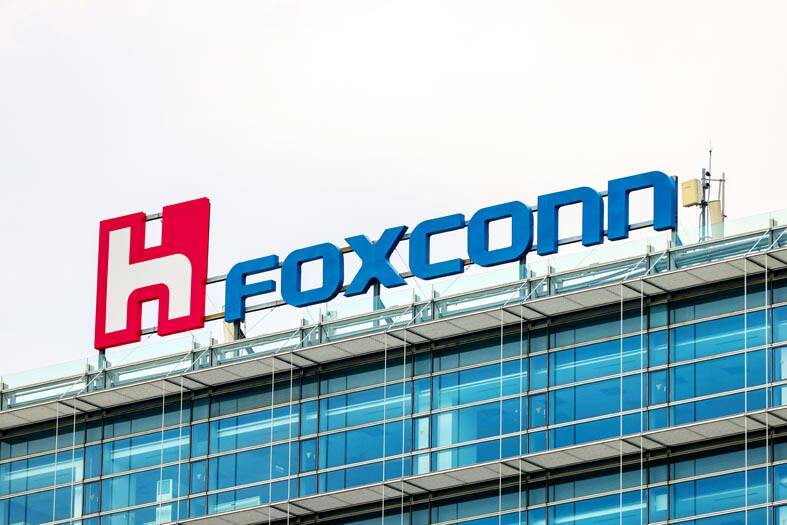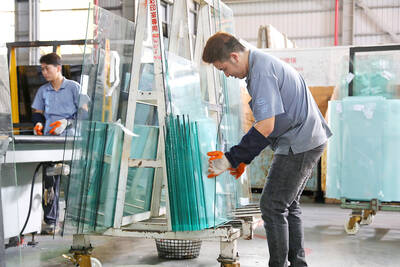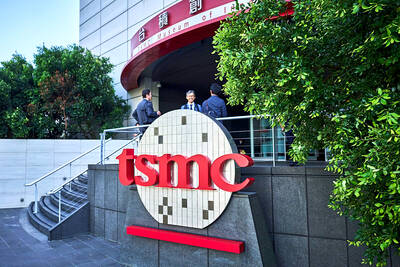Hon Hai Precision Industry Co (鴻海精密), a major iPhone assembler, yesterday posted the best third-quarter profit in the company’s history, backed by stronger-than-expected demand for artificial intelligence (AI) servers and smartphones.
Net profit expanded 14 percent annually to NT$49.33 billion (US$1.52 billion) from NT$43.13 billion in the third quarter last year, the company said. On a quarterly basis, net profit soared 41 percent from NT$35.05 billion.
The company said gross profit expanded 12 percent annually and 15 percent sequentially to NT$114.73 billion last quarter, the best for the period on record.

Photo: EPA-EFE
However, gross margin fell to 6.19 percent last quarter, from 6.66 percent a year earlier and 6.42 percent in the previous quarter, which the company attributed to higher shipments of AI servers, which have lower gross margin.
The growth momentum in AI servers is to extend into next year, boosting AI server revenue to account for half of the total server revenue compared with 40 percent this year, Hon Hai chairman Young Liu (劉揚偉) told investors yesterday.
“We expect AI servers to enjoy high-speed growth over the next few years. We are optimistic about 2025. Hon Hai will be ushered into the next stage of growth,” Liu said.
Hon Hai expects strong demand for high-end AI servers powered by Nvidia Corp’s GB200 chips, Liu said.
Together with regular servers, the cloud and networking product business is to become another revenue pillar for the company next year, in addition to the smartphone business, he said.
Last quarter, the cloud and networking product business accounted for 32 percent of Hon Hai’s overall revenue of NT$1.85 trillion, up from 22 percent in the third quarter last year. Smartphones made up 45 percent, shrinking from 54 percent a year earlier.
However, a dismal car industry and a conservative attitude toward adopting new technology by traditional automakers led to a slower-than-expected adoption of Hon Hai’s electric vehicles.
“We have to put off the timeframe for our goal to get a 5 percent share of the world’s electric vehicle market,” Liu said.
The company had aimed to hit that target next year with annual revenue of NT$1 trillion.
In light of US president-elect Donald Trump’s return to the White House in January next year, Liu said Hon Hai would continue investing in the US as part of the company’s global manufacturing expansion.
Over the past 40 years, Hon Hai has set up 50 manufacturing sites in the US, with US$25.6 billion in revenue.
This quarter, Hon Hai’s cloud and networking product business is expected to see strong growth from a year earlier, thanks to rising AI server shipments, Liu said.
During the first three quarters of this year, AI server revenue has tripled from a year earlier, while the growth for regular servers was 20 percent, he said.
The computing products business is to see a mild decline in revenue this quarter compared with the same period last year, although a significant decline quarter-on-quarter is expected due to a higher comparison base, he said.
Revenue from the component and other products business, which includes connectors, camera modules and auto parts, this quarter is to be little changed from the same period last year, but a significant growth from the previous quarter, he added.
Overall, Hon Hai is to deliver significant revenue growth this year with clearer business visibility ahead, Liu said.

CAUTIOUS RECOVERY: While the manufacturing sector returned to growth amid the US-China trade truce, firms remain wary as uncertainty clouds the outlook, the CIER said The local manufacturing sector returned to expansion last month, as the official purchasing managers’ index (PMI) rose 2.1 points to 51.0, driven by a temporary easing in US-China trade tensions, the Chung-Hua Institution for Economic Research (CIER, 中華經濟研究院) said yesterday. The PMI gauges the health of the manufacturing industry, with readings above 50 indicating expansion and those below 50 signaling contraction. “Firms are not as pessimistic as they were in April, but they remain far from optimistic,” CIER president Lien Hsien-ming (連賢明) said at a news conference. The full impact of US tariff decisions is unlikely to become clear until later this month

With an approval rating of just two percent, Peruvian President Dina Boluarte might be the world’s most unpopular leader, according to pollsters. Protests greeted her rise to power 29 months ago, and have marked her entire term — joined by assorted scandals, investigations, controversies and a surge in gang violence. The 63-year-old is the target of a dozen probes, including for her alleged failure to declare gifts of luxury jewels and watches, a scandal inevitably dubbed “Rolexgate.” She is also under the microscope for a two-week undeclared absence for nose surgery — which she insists was medical, not cosmetic — and is

GROWING CONCERN: Some senior Trump administration officials opposed the UAE expansion over fears that another TSMC project could jeopardize its US investment Taiwan Semiconductor Manufacturing Co (TSMC, 台積電) is evaluating building an advanced production facility in the United Arab Emirates (UAE) and has discussed the possibility with officials in US President Donald Trump’s administration, people familiar with the matter said, in a potentially major bet on the Middle East that would only come to fruition with Washington’s approval. The company has had multiple meetings in the past few months with US Special Envoy to the Middle East Steve Witkoff and officials from MGX, an influential investment vehicle overseen by the UAE president’s brother, the people said. The conversations are a continuation of talks that

Alchip Technologies Ltd (世芯), an application-specific integrated circuit (ASIC) designer specializing in artificial-intelligence (AI) chips, yesterday said that small-volume production of 3-nanometer (nm) chips for a key customer is on track to start by the end of this year, dismissing speculation about delays in producing advanced chips. As Alchip is transitioning from 7-nanometer and 5-nanometer process technology to 3 nanometers, investors and shareholders have been closely monitoring whether the company is navigating through such transition smoothly. “We are proceeding well in [building] this generation [of chips]. It appears to me that no revision will be required. We have achieved success in designing